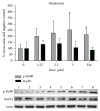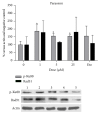Screening of Pesticides with the Potential of Inducing DSB and Successive Recombinational Repair
- PMID: 29129974
- PMCID: PMC5654340
- DOI: 10.1155/2017/3574840
Screening of Pesticides with the Potential of Inducing DSB and Successive Recombinational Repair
Abstract
A study was realized to ascertain whether eight selected pesticides would induce double strand breaks (DSB) in lymphocyte cultures and whether this damage would induce greater levels of proteins Rad51 participating in homologous recombination or of p-Ku80 participating in nonhomologous end joining. Only five pesticides were found to induce DSB of which only glyphosate and paraoxon induced a significant increase of p-Ku80 protein, indicating that nonhomologous end joining recombinational DNA repair system would be activated. The type of gamma-H2AX foci observed was comparable to that induced by etoposide at similar concentrations. These results are of importance since these effects occurred at low concentrations in the micromolar range, in acute treatments to the cells. Effects over longer exposures in actual environmental settings are expected to produce cumulative damage if repeated events of recombination take place over time.
Figures



References
-
- WHO, World Health Organization. 2016, www.who.int/topics/pesticides/en/
-
- Environmental Protection Agency, EPA. 2016, https://www.epa.gov/pesticide-reevaluation/registration-review-process.
-
- CICLOPLAFEST. Catálogo de Plaguicidas. Cofepris. 2004 http://www.cofepris.gob.mx/AZ/Paginas/Plaguicidas%20y%20Fertilizantes/Ca....
-
- Albert LA. Panorama de los plaguicidas en México. revista de toxicología en línea. Retel. 2005;8(1):p. 17. www.sertox.com.ar/retel.
LinkOut - more resources
Full Text Sources
Other Literature Sources
Research Materials

